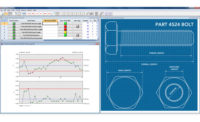Today’s modern quality software technologies use advanced, yet simple, analysis tools to provide actionable information at a higher level, than older technology allowed for. Neither spreadsheets nor control charts were designed to easily portray large amounts of diverse quality data, but modern SPC software allows leaders to view a clear picture of organizational quality across production lines and plants.
These technologies use comparative analysis tools to make it easy to gain insights from data.
Organizations can use these tools to proactively generate broad information that can enable strategy, and to boost quality and lower costs.
By looking at quality as a strategic initiative across the enterprise, instead of focusing on fighting yesterday’s fires, leaders can transform their organization’s performance. Here are four steps leaders can take to boost ROI when using SPC software:
1. Access big-picture quality information
Looking at that big picture of quality means seeing cumulative amounts of data, condensing it, and evaluating it all at the same time. SPC software helps leaders to do this so that they are seeing apples to apples comparisons of product code specifications and plant performance, not apples to oranges. This enables leaders to interpret and learn from data across plants, lines, and products, among other conglomerations.
2. Analyze that information in a detailed way
SPC software should enables quality professionals to look across all plant locations of a given company, review the data, and make quality improvement decisions. This helps manufacturers prioritize efforts as they relate to machinery, product-specific data, regional data, and overall plant performance. This is called comparative analysis. Manufacturers can use this method to identify their best or worst performing products, machine tools, and plants.
3. Identify quality-related opportunities for improvement
By assessing enterprise-wide quality data, leaders can pinpoint problems and opportunities for improvement, prioritize next steps and address issues strategically. This ultimately helps them become better leaders and delegate work more efficiently. When company leadership has access to big picture quality data, they can direct talented staff are toward broadly useful, transformative projects.
4. Perform these analyses regularly
Companies who schedule data analysis sessions consistently win out, experts say. Regular data review sets the tone that quality is important. Schedule meetings also ensure that busy staff will find time to prioritize quality
Reviewing aggregated data helps leaders to make time for short-or long-term improvement work and can expose hidden opportunities for immense cost savings and quality improvements that can maximize the value of SPC software systems.



